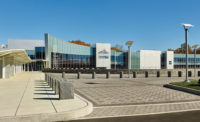In the past few years, there has been greater recognition for the role sound plays in creating occupant comfort in homes, schools, workplaces and healthcare facilities. As families today are trending smaller, many new buyers are moving into modest-sized one- and two-bedroom homes or townhomes and condos in urban settings. Most people need a reasonable degree of quiet to concentrate, relax or feel comfortable, and as such, wall assemblies are playing a greater role in the management of sound and indoor environmental quality.
Sound travels as waves. Waves that move through solids just as they do the air, albeit at different speeds. Some materials are good conductors of sound waves while others are not so good. In acoustic control for buildings, the goal is to employ poor sound conductors in the wall, ceiling and floor assemblies. In most wall assembly acoustic design, there are two basic schools of thought with regard to how to disrupt these waves.
One approach is to add more mass with an additional layer of gypsum board along with a resilient channel or some kind of acoustic clip in order to limit the sound transmission. It’s like trying to shake a heavy mass at the end of a spring. The less that mass moves, the less sound will be transmitted into the next space. In this approach, as with the second, fiberglass insulation is added to help further dampen the sound transmission between the two sides of the wall where there isn’t any framing. Ever try to talk through a fiberglass batt? Together with the decoupling of the structure by adding the spring these efforts significantly reduce the amount of sound that gets through.
Noise-reducing Engineered
Another, relatively newer approach, is to install factory-laminated, noise-reducing gypsum board sometimes referred to as acoustic gypsum board. This takes the place of the more complex resilient channel system described in the first approach. It is designed to dampen sound energy at a much higher level than standard gypsum board but can function and install within the parameters of a standard wall assembly (without adding thickness!).
One example, SilentFX QuickCut, is engineered using two dense gypsum boards to sandwich an inner layer of viscoelastic polymer. This polymer acts like a shock absorber to dampen the vibrations of sound energy as it tries to pass through. This type of “constrained layer damping” board product cuts like standard drywall, but performs well acoustically over an extended range of frequencies, resulting in increased STC (sound transmission class) ratings for the wall.
Because noise reducing board looks, handles and installs like standard gypsum board, it is often a much simpler solution than adding a multi-component resilient channel.
Sound Control & Solutions
Acoustic gypsum board also has advantages because it is less prone to ‘short circuiting’ from over driven fasteners. This is unfortunately common in resilient channel applications in the real world. Nature seeks a path of least resistance so it’s important to eliminate as many holes through, or bridges around, any line of control you are trying to establish (usually resistance to a force- in this case sound). Perhaps this is why in nature, simple is often the solution that succeeds. It has a better chance of being built.
For spaces that need a much higher level of acoustic control, there are more advanced and more costly techniques available. Walls with a double row of studs on separate top and bottom plates and one or more layers of gypsum board attached to each room side are one common solution. This technique makes a thick wall where one side has no physical attachment to the other. These are often used in recording studios and other applications where elimination of exterior noise is critical.
For most projects however, adding a resilient channel or using acoustic gypsum board will provide a cost-effective solution that will meet the project needs. Be thoughtful though and don’t let material costs alone make the decision for you on which approach to take. Acoustic gypsum boards may cost more than standard gypsum but they eliminate acoustic clips and/or resilient channel with its associated labor and added thickness. Did I mention less labor?







